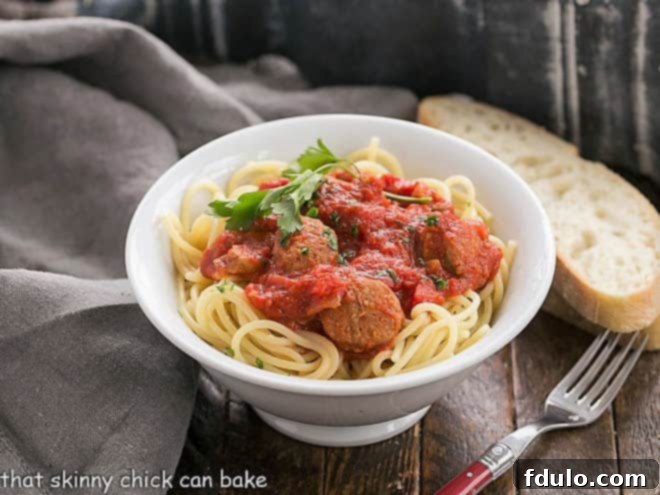Experience a homemade culinary revelation with this unparalleled Pasta Sauce Recipe. Crafted with intention and a thoughtful layering of exquisite flavors, this recipe delivers a truly exceptional Homemade Pasta Sauce that promises to become a cherished staple in your kitchen. Prepare to be captivated by its richness and depth, making it a dish you’ll eagerly recreate time and again!
From the moment the fragrant red wine meets savory Italian sausages, and the potent aromatics blend with a curated selection of spices, your kitchen will transform into an authentic Italian eatery. This recipe doesn’t just promise a meal; it delivers the very best spaghetti sauce you can create, right from your own stove.
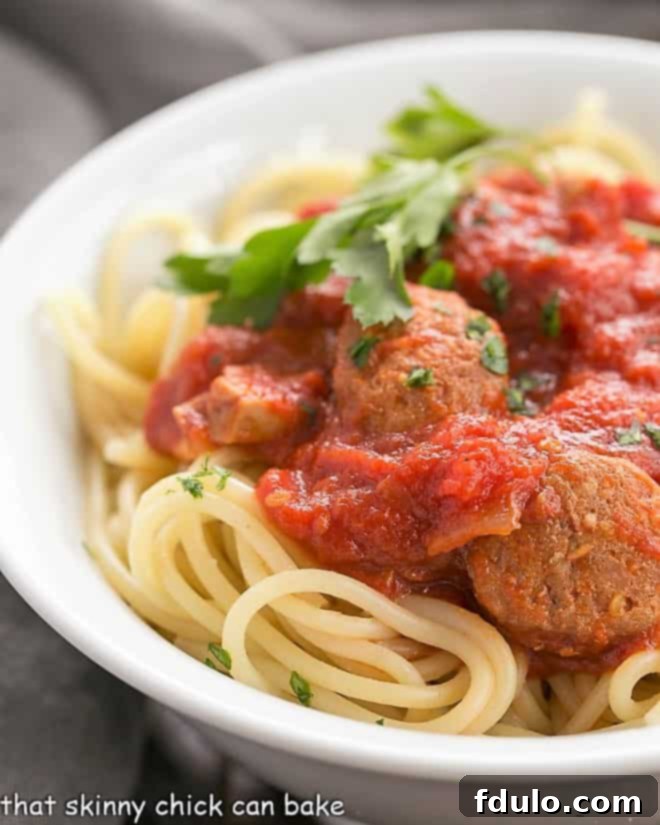
Why This Homemade Pasta Sauce Will Transform Your Cooking
Embarking on the journey of making your own pasta sauce is far more rewarding than simply opening a jar. This recipe, in particular, stands out for several compelling reasons:
- Uncomplicated Excellence: Despite its rich flavor profile, crafting this homemade pasta sauce demands surprisingly little hands-on time. The magic primarily happens during a slow, gentle simmer, allowing all the premium ingredients to harmoniously meld and deepen in flavor. It’s a testament to the fact that extraordinary taste doesn’t always require endless fuss.
- A Jar-Free Future: Once you discover the sheer simplicity and incredible depth of flavor that comes from a truly homemade sauce, the thought of returning to store-bought jarred varieties will become a distant memory. This recipe offers a taste experience that is fresh, vibrant, and utterly superior to anything pre-packaged.
- Quality You Can Trust: The beauty of cooking from scratch lies in knowing exactly what goes into your meal. By selecting fresh, high-quality ingredients, you ensure a sauce that is not only bursting with natural flavor but also free from unnecessary additives. This commitment to quality inevitably leads to the most delicious spaghetti sauce you’ve ever savored, tailored perfectly to your preferences.
- Impress Your Guests: Whether it’s a casual weeknight dinner or a special gathering, serving a homemade pasta sauce crafted with such care is always a showstopper. Your family and friends will undoubtedly notice and appreciate the rich, authentic flavors, making every meal a memorable occasion.
- Cost-Effective and Rewarding: While the initial investment in quality ingredients is key, making sauce from scratch often proves more economical in the long run than repeatedly purchasing gourmet jarred options. Beyond the financial aspect, the immense satisfaction derived from creating such a flavorful dish from start to finish is truly priceless.

Key Ingredients for an Unforgettable Pasta Sauce
The secret to a truly great pasta sauce lies not just in the ingredients themselves, but in understanding their individual contributions and how they interact to build a symphony of flavors. Here’s a closer look at the essential components of our incredible recipe:
- Aromatics: The Flavor Foundation
This crucial category includes fresh vegetables, herbs, and spices that lay the groundwork for a rich and complex sauce. Our recipe utilizes onion, garlic, bell pepper, mushrooms, and bay leaves. These ingredients are sautéed to release their fragrant oils and sweet notes, forming the initial aromatic base that defines the sauce’s character. Don’t underestimate their power; they are the unsung heroes of depth. - Quality Olive Oil: The Flavor Extractor
Olive oil serves as more than just a cooking medium; it’s a vital tool for extracting and carrying the flavors of the initial aromatics and sausage. Opt for a good quality extra virgin olive oil, but one that is suitable for sautéing. Its fruity notes subtly enhance the overall profile, ensuring a silky texture and contributing to the sauce’s luxurious mouthfeel. - Tomatoes and Tomato Paste: The Heart of the Sauce & Umami Boost
No Italian pasta sauce is complete without its tomato foundation. We use both crushed or plum tomatoes for their bright, fresh flavor, and tomato paste for its concentrated sweetness and depth. Tomato paste, in particular, is a powerhouse of umami – that savory fifth taste profile alongside sweet, salty, bitter, and sour. Natural glutamates found in tomatoes provide this rich, satisfying savoriness, distinguishing a truly gourmet sauce. - Worcestershire Sauce and Italian Sausage: Unexpected Umami Enhancers
While not traditionally found in every spaghetti sauce, Worcestershire sauce is a secret weapon that adds an incredible layer of complexity and a significant umami boost. Its fermented ingredients create a depth of flavor that is hard to replicate. Similarly, Italian sausage isn’t just for texture and protein; its spices and the natural glutamates in the meat contribute a profound savory element, elevating the sauce from good to extraordinary. Feel free to choose mild, sweet, or spicy varieties to tailor the heat level to your preference. - Angostura Bitters: The Mystery Ingredient for Depth
This might seem like an unusual addition, typically reserved for cocktails, but Angostura bitters is a blend of over 40 herbs and spices (including gentian) with a top-secret formula. A few dashes can impart an unparalleled “depth and complexity” to savory dishes, much like a chef’s secret weapon, as highlighted by culinary experts. If you don’t have it on hand, the sauce will still be delicious, but for an extra layer of sophistication, it’s worth trying. - Dry Red Wine: The Flavor Amplifier
Like salt, red wine acts as a powerful flavor enhancer. Adding it early in the cooking process allows the alcohol to evaporate completely, leaving behind only its rich, fruity, and acidic notes. These elements brighten the sauce, help deglaze the pan (lifting all those delicious browned bits, or ‘fond’), and add a sophisticated layer that deepens as the sauce simmers. Choose a dry, medium-bodied red wine that you would enjoy drinking. - Sugar: Balancing Acidity
A small amount of sugar helps to balance the acidity of the tomatoes, creating a well-rounded and harmonious flavor profile without making the sauce overtly sweet. It’s a subtle touch that makes a significant difference. - Celery Salt: A Hidden Gem
Celery salt provides a background note that rounds out the savory profile. Its subtle herbaceous and salty qualities complement the other aromatics beautifully, adding another layer of complexity without overpowering.
Mastering the Art of Homemade Pasta Sauce: A Step-by-Step Guide
Crafting this flavorful pasta sauce is a methodical process where the order of operations is key to unlocking the full potential of each ingredient. Follow these steps to build a sauce with unparalleled depth and taste:
- 1. Build the Aromatic Base: Begin by heating a generous amount of good quality olive oil in a large, heavy-bottomed pot or Dutch oven over medium heat. This initial fat is crucial for extracting flavors. Once shimmering, add your diced onions and minced garlic. Sauté gently until the onions become translucent and soft, and the garlic is fragrant – be careful not to burn the garlic, as it can turn bitter. This step establishes the foundational aroma and sweetness of your sauce.
- 2. Brown the Italian Sausage for Maximum Flavor: Next, add the sliced Italian sausage to the pot. Cook it over medium heat, breaking it apart with a spoon, until it is thoroughly browned. This browning process is not just about cooking the meat; it’s about initiating the Maillard reaction. This complex chemical reaction between amino acids and reducing sugars creates hundreds of new flavor compounds, giving browned and grilled foods their distinctive, savory, and irresistible taste. These browned bits, known as ‘fond,’ are pure flavor gold.
- 3. Deglaze with Red Wine: Once the sausage is beautifully browned, pour in the dry red wine. As the wine hits the hot pan, use a wooden spoon to scrape up all those flavorful browned bits (the ‘fond’) from the bottom of the pot. This process, known as deglazing, incorporates all that concentrated flavor back into the sauce. Allow the wine to simmer for a minute or two, letting the alcohol evaporate while its rich, complex flavors infuse into the base. As a flavor enhancer, the wine contributes a sophisticated layer that will deepen during the long simmer.
- 4. Introduce the Remaining Ingredients for the Simmer: After deglazing, it’s time to add the rest of the sauce ingredients: diced bell peppers, diced mushrooms, concentrated tomato paste (which you’ll want to cook for a minute to deepen its flavor), crushed or plum tomatoes, Worcestershire sauce, Angostura bitters (if using), sugar, salt, black pepper, celery salt, and bay leaves. Stir everything together thoroughly to combine.
- 5. The Art of the Slow Simmer: Bring the sauce to a gentle simmer, then reduce the heat to very low. Cover the pot partially, allowing some steam to escape, and let it cook slowly for 2.5 to 3 hours. This extended simmering time is where the magic truly happens: flavors deepen, ingredients meld, and the sauce develops its signature richness and complexity. Stir occasionally to prevent sticking. If the sauce becomes too thick for your liking during this time, you can add a little water or broth to reach your desired consistency. The patience exercised during this stage will be amply rewarded with an incredibly flavorful sauce.
- 6. Final Touches and Serving: Once the sauce has simmered to perfection, remove the bay leaves. Taste and adjust seasonings as needed, adding more salt or pepper if desired. Serve this magnificent homemade pasta sauce generously over your favorite warm spaghetti, cooked al dente in well-salted water. A sprinkle of freshly grated Parmesan cheese is the perfect finishing touch, adding a salty, nutty counterpoint to the rich sauce.
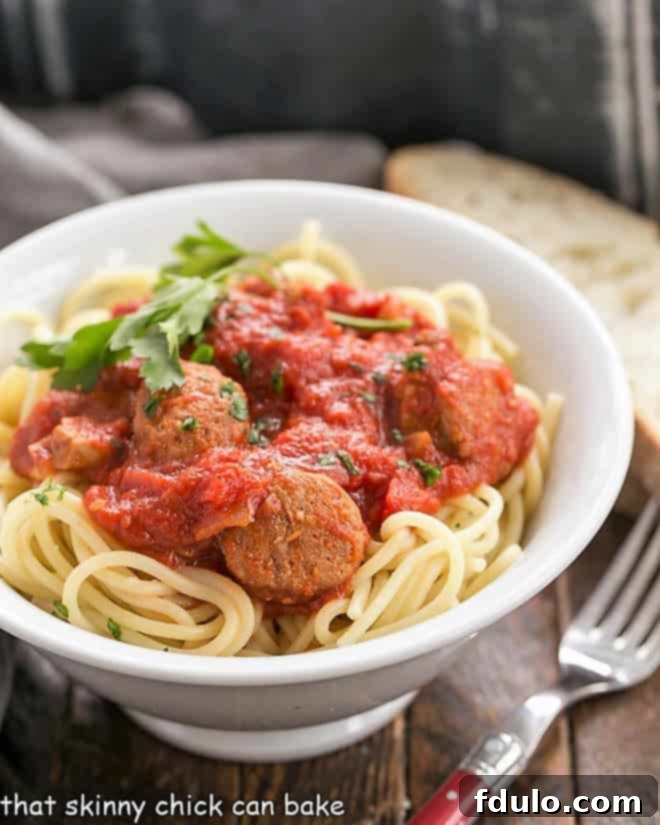
Expert Tips for the Best Homemade Pasta Sauce
Elevate your pasta sauce game with these clever tips and tricks from experienced home cooks:
- PRO-Tip: Effortless Tomato Paste Extraction: Dealing with sticky tomato paste can be messy. To easily get every last bit out of the can, simply remove both ends of the can. Then, use one of the removed lids to push the paste through the can from the opposite end. The lid acts as a perfect scraper, ensuring zero waste and minimal mess.
- Waste Not, Want Not: Storing Leftover Wine: If you often find yourself with a small amount of leftover red wine after a dinner party, don’t let it go to waste. Pour it into small freezer-grade Ziploc bags, seal them tightly, and freeze flat. Alternatively, you can pour the wine into ice cube trays, freeze until solid, then transfer the wine cubes to a larger freezer-safe Ziploc bag. This way, you’ll always have convenient, single-serving portions of wine readily available for deglazing or adding depth to your next sauce or stew. (Pro-tip from experience: always double-bag to prevent any potential leaks in your freezer!)
- PRO-Tip: Perfectly Slicing Italian Sausage: Slicing raw Italian sausage links can be challenging. For cleaner, more uniform slices, don’t completely defrost frozen sausage links. It’s significantly easier and safer to slice them when they are still partially frozen. This semi-solid state provides better control and prevents the sausage from squishing.
- Enhance with Fresh Herbs: While dried herbs are used in the simmering process, consider stirring in a handful of fresh chopped basil or parsley during the last 15-20 minutes of cooking, or as a garnish before serving. Fresh herbs add a vibrant, aromatic burst that brightens the sauce’s overall flavor profile.
- Don’t Forget the Salt for Pasta Water: When cooking your spaghetti, remember to heavily salt the boiling water. The pasta absorbs this seasoning, which greatly enhances its own flavor and, in turn, the flavor of your entire dish. It should taste like the sea!
- Make Ahead and Freeze: This homemade pasta sauce is an excellent candidate for meal prepping. Make a large batch, let it cool completely, then portion it into freezer-safe containers or bags. It freezes beautifully for up to 3-4 months, making busy weeknights a breeze with a delicious, homemade meal just a reheat away.
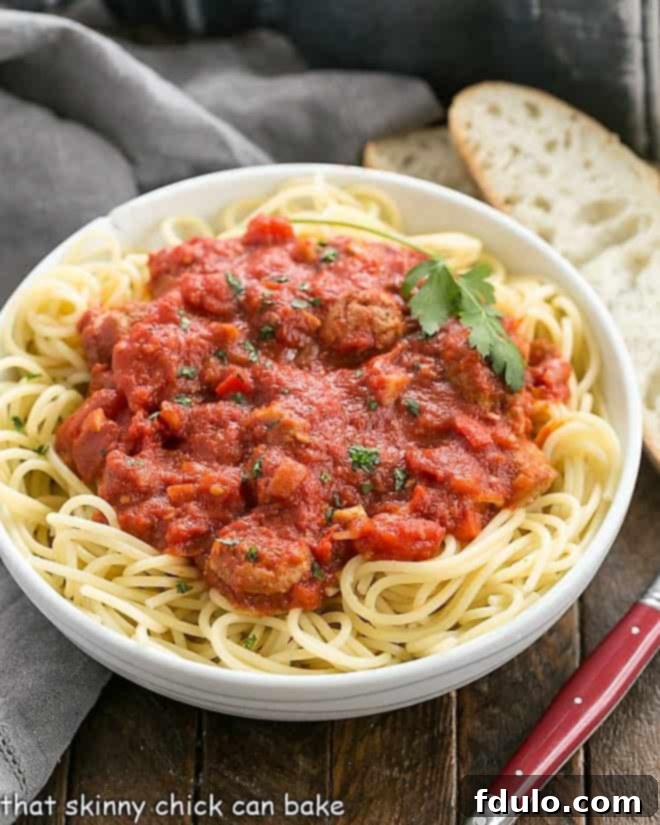
Frequently Asked Questions About Homemade Pasta Sauce
Marinara is generally a much simpler and quicker pasta sauce, typically made with tomatoes, minimal aromatics like onion and/or garlic, and a few basic herbs such as basil or oregano. It originated in Naples, Italy, as a “sailor’s style” sauce, hence its name. Classic Italian pasta dishes like spaghetti aglio e olio, spaghetti alla puttanesca, and spaghetti alla carbonara also have distinct Italian roots.
American-style spaghetti sauces, like this recipe, often build upon the marinara base but incorporate additional ingredients. They commonly include meat (such as meatballs, sausage, or ribs), a wider variety of vegetables (bell peppers, mushrooms), and sometimes more complex seasonings to create a richer, heartier, and more robust sauce.
Absolutely! Homemade spaghetti sauce is an excellent candidate for freezing, allowing you to enjoy its deliciousness long after preparation. Once the sauce has cooled completely to room temperature, transfer it into freezer-safe containers or heavy-duty freezer bags. Ensure there’s a little headspace if using rigid containers, as the sauce will expand slightly when frozen. Properly stored, it can be kept in the freezer for up to 3-4 months without significant loss of quality. For best results, thaw it in the refrigerator overnight before reheating gently on the stovetop. Leftovers kept in the refrigerator should be consumed within 3-4 days.
Yes, this rich spaghetti sauce recipe can certainly be adapted for a slow cooker or Crockpot, making it a convenient option for busy days. However, to truly capture the depth of flavor, it’s crucial not to skip the initial sautéing and browning steps. First, brown the garlic, onion, and Italian sausage in a skillet on the stovetop. Then, deglaze the pan with red wine, scraping up all the flavorful fond. Once these steps are complete, transfer the browned ingredients and the deglazing liquid to your slow cooker along with the remaining sauce ingredients. Cook on the LOW setting for approximately 7-8 hours or on HIGH for 3-4 hours, until the sauce is rich and well-melded. This initial stovetop work ensures you don’t sacrifice flavor for convenience.
This versatile, hearty sauce pairs beautifully with a variety of pasta shapes. Classic choices include long strands like spaghetti, linguine, or fettuccine, which allow the rich sauce to cling perfectly. Shorter, heartier shapes such as rigatoni, penne, or fusilli are also excellent, especially for catching bits of sausage and vegetables within their grooves. Ultimately, the best pasta is your personal favorite, cooked to a perfect al dente texture.
To transform this recipe into a delicious vegetarian pasta sauce, simply omit the Italian sausage and Worcestershire sauce. Instead, you can boost the umami and texture with extra mushrooms (cremini or portobello work well), diced zucchini, or plant-based Italian “sausage” alternatives. A touch of smoked paprika or liquid smoke can also add a subtle depth reminiscent of savory meats. Be sure to still sauté your aromatics in olive oil to build a robust flavor base.
Explore More Delicious Pasta & Main Course Recipes
If you’ve fallen in love with this Homemade Pasta Sauce, you’ll surely enjoy exploring other delectable dishes that will elevate your culinary repertoire. Discover more inspiration below:
- Garlic Shrimp Pasta from Copykat Recipes – A quick and flavorful seafood option.
- Spinach Stuffed Pasta Shells – Comfort food at its finest, perfect for a family dinner.
- Cheesy Baked Pasta – An ultimate indulgence for cheese lovers.
- Penne alla Vodka – A creamy and vibrant pasta dish with a touch of sophistication.
- Classic Italian Meat Sauce – For those who crave traditional, slow-cooked goodness.
- More Pasta Recipes – A comprehensive collection to satisfy all your pasta cravings.
- More Main Course Recipes – Expand your dinner ideas with a variety of delicious entrees.
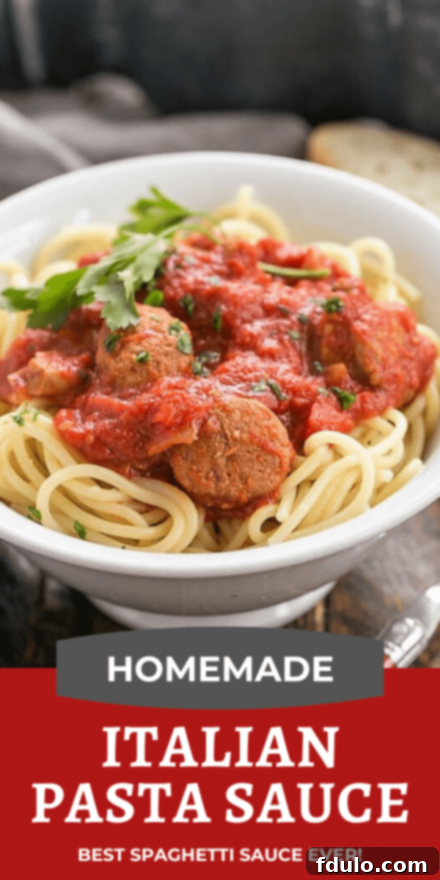
We love connecting with our amazing community! Stay in touch through social media @ Instagram, Facebook, and Pinterest. Don’t forget to tag us when you try one of our recipes! And if you truly adore the results of this Homemade Pasta Sauce, please consider giving it a 5-star rating in the recipe card below. Your feedback helps us share more delicious recipes with you!
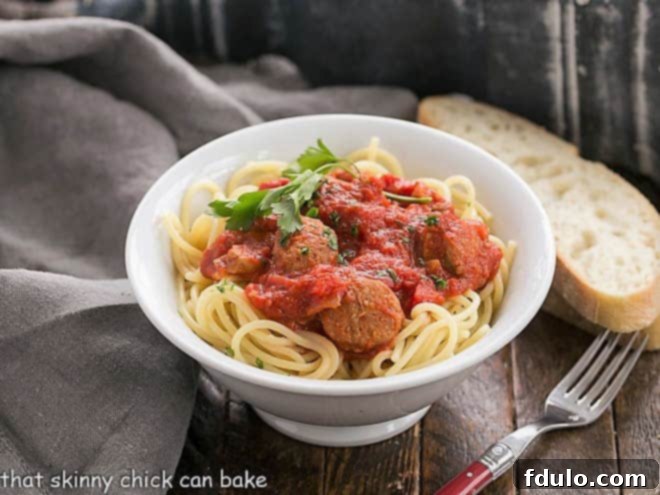
Homemade Pasta Sauce Recipe with Sausage
20 minutes
2 hours 30 minutes
2 hours 50 minutes
8 servings
Discover the ultimate Homemade Pasta Sauce with Sausage! This recipe builds incredible layers of flavor, transforming simple ingredients into a rich, slow-simmered delight that’s perfect for any occasion. Prepare to create the best spaghetti sauce you’ve ever tasted!
Ingredients
- ½ cup yellow onion, diced (about 1 medium onion)
- 2 cloves garlic, minced (freshly minced for best flavor)
- ¼ cup extra virgin olive oil
- 1 pound mild, sweet, or spicy Italian sausage links, casings removed and cut into slices or crumbled
- ½ cup dry red wine (such as Chianti, Merlot, or Pinot Noir)
- ½ red bell pepper, diced (adds a subtle sweetness and color)
- 8 ounces fresh mushrooms, diced (cremini or button mushrooms work well)
- 1 (6-ounce) can tomato paste (for intense tomato flavor and richness)
- 2 (28-ounce) cans high-quality plum tomatoes (San Marzano are highly recommended), crushed by hand or roughly diced
- 1 ½ teaspoons Worcestershire sauce (for an added layer of umami)
- 3-5 dashes Angostura bitters, optional (a secret ingredient for depth and complexity)
- 1 tablespoon granulated sugar (to balance tomato acidity)
- ½ teaspoon salt, or to taste
- ¼ teaspoon fresh ground black pepper, or to taste
- ½ teaspoon celery salt (enhances savory notes)
- 2 bay leaves
Instructions
- Sauté Aromatics and Sausage: In a large Dutch oven or a similar-sized heavy-bottomed pan, heat the olive oil over medium heat. Add the diced onion and minced garlic, sautéing until the onion is translucent and soft, about 5-7 minutes. Be careful not to burn the garlic. Add the sliced or crumbled Italian sausage and cook, breaking it up with a spoon, until it is thoroughly browned on all sides. This step is crucial for developing deep, rich flavors.
- Deglaze the Pan: Pour in the dry red wine. Use a wooden spoon to scrape up all the flavorful browned bits (fond) from the bottom of the pan, incorporating them into the liquid. Let the wine simmer for about a minute, allowing the alcohol to evaporate.
- Add Remaining Ingredients: Stir in the diced red bell pepper, diced mushrooms, and tomato paste. Cook for 2-3 minutes, stirring, to slightly caramelize the tomato paste and deepen its flavor. Then, add the crushed or plum tomatoes, Worcestershire sauce, Angostura bitters (if using), sugar, salt, black pepper, celery salt, and bay leaves. Stir everything together until well combined.
- Slow Simmer: Bring the sauce to a gentle simmer, then reduce the heat to very low. Cover the pan partially (leaving a small gap for steam to escape) and let the sauce simmer for 2½ to 3 hours, stirring occasionally. This long, slow simmer allows all the flavors to meld beautifully and the sauce to thicken into a rich consistency. If the sauce becomes too thick, you can add a little water or low-sodium broth.
- Serve and Enjoy: Once the sauce has achieved your desired richness and consistency, remove the bay leaves. Taste and adjust seasonings as needed. Serve the warm sauce generously over your favorite spaghetti, cooked al dente in well-salted water. Garnish with freshly grated Parmesan cheese and a sprinkle of fresh basil or parsley, if desired.
Notes
This recipe for Homemade Pasta Sauce is adapted from the “Creme de Colorado Cookbook,” showcasing timeless techniques for building incredible flavor. For a vegetarian option, omit the sausage and Worcestershire sauce, and consider adding more mushrooms or a plant-based sausage alternative for texture and umami.
Nutrition Information:
Yield:
8 servings
Serving Size:
1 serving
Amount Per Serving:
Calories: 352Total Fat: 23gSaturated Fat: 7gTrans Fat: 0gUnsaturated Fat: 18gCholesterol: 32mgSodium: 666mgCarbohydrates: 22gFiber: 5gSugar: 13gProtein: 15g
Nutritional content is for the pasta sauce alone. Calories and other nutritional values will vary depending on the amount and type of pasta used, and any additional toppings. This information is an estimate.
HOW MUCH DID YOU LOVE THIS RECIPE?
Please leave a comment on the blog or share a photo on Pinterest and tag us!
